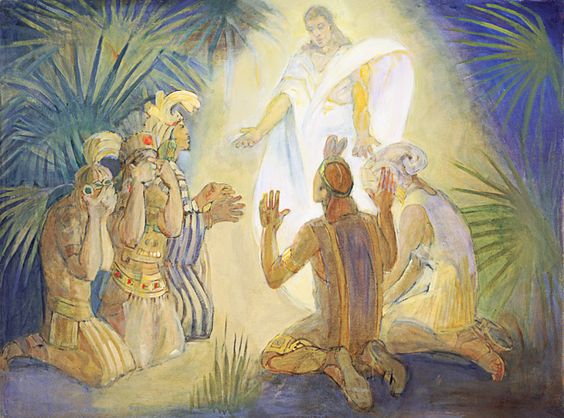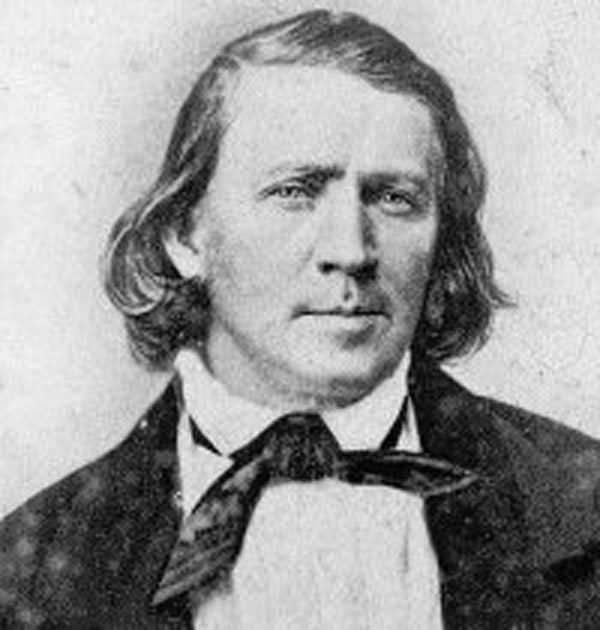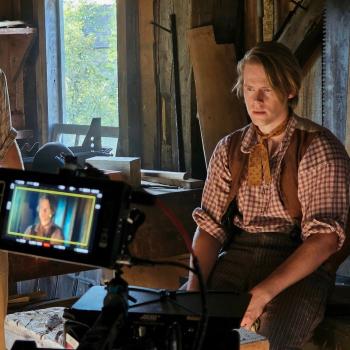
(Minerva Teichert, ca 1950-51; LDS.org)
Happy weekend! Two new articles appeared today on the website of the Interpreter Foundation:
““According to the Spirit of Revelation and Prophecy”: Alma2’s Prophetic Warning of Christ’s Coming to the Lehites (and Others),” written by Matthew Scott Stenson
Abstract: Some students of the Book of Mormon have felt that while the coming of the Lord to the Lehites was clearly revealed to and taught by Nephi1, those prophecies having to do with the subject may not have been widely circulated or continuously preserved among the Nephites, while others have argued for continuity of knowledge about Nephi1’s prophecies among writers and their contemporary audiences. Reexamination of the Book of Mormon in light of these issues reveals that the teaching that Christ would appear among the Lehites was actually taught with some consistency by Alma2 and was, it would seem, common knowledge among the Nephites. It appears that the predicted coming was well established, even if the nature of it was not. Specifically, I argue that Alma2 often taught of the coming of Christ to the Lehites but in context with other events such as Jesus’s coming to the Jews and to others not of the known fold. To make this case, I concentrate on Alma2’s writings, especially those in Alma 5 (borrowing liberally also from Alma 7, 13, 16, 39, Helaman 16:4–5, 13–14, and 3 Nephi 8–10). Alma 5 houses many prophetic statements that urgently point to the coming of the Lord to the Nephite church. The value of this approach is to attempt to demonstrate that Alma 5 contains more than has been supposed and, in effect, challenges claims for discontinuity in the middle portion of the Nephite record. This approach should tend to renew our interest in the other nuanced teachings of the prophet Alma2 and others.
“Interpreting Interpreter: The Limitations of Discontinuity”
This post is a summary of the article ““According to the Spirit of Revelation and Prophecy”: Alma2’s Prophetic Warning of Christ’s Coming to the Lehites (and Others)” by Matthew Scott Stenson in Volume 55 of Interpreter: A Journal of Latter-day Saint Faith and Scholarship. An introduction to the Interpreting Interpreter series is available at https://interpreterfoundation.org/interpreting-interpreter-on-abstracting-thought/.
The Takeaway: Stenson uses Alma 5 (among other examples) to argue for a middle ground between those who argue for a continuity in the use and awareness of prophecies of Christ’s coming in the Book of Mormon, and those who argue for a break in that continuity, suggesting that Alma’s allusions to the small plates meant that later Nephites had at least some knowledge of Nephi’s prophetic tradition.

(Wikimedia Commons public domain image)
In connection with the Interpreter Foundation’s “Six Days in August” film project, which is in its very opening phase, I’ve lately begun to re-read Thomas G. Alexander, Brigham Young and the Expansion of the Mormon Faith (Norman: University of Oklahoma Press, 2019). Here is a passage that caught my attention with regard to his integrity. I doubt that anybody potentially decades later and back in New York really expected, or even thought of the possibility, that Brigham Young would remember and seek to pay off his old debts. And, pretty certainly, nobody could realistically have sought to enforce them. Nevertheless, he sought to do the right thing:
Although he worked hard, Young incurred a number of debts while in Port Byron and Mendon, largely in his effort to keep his family afloat. He was unable to repay many of these debts until emigrating to Utah years later, though he did keep track of the notes he had signed. Later in life, he would send his son, John W. Young, and his friend, William W. Riter, at times to repay them with simple interest at 7 percent. Commenting on one such visit from John W. Young, the Auburn Advertiser Union noted: “Brigham is honest in some things, but rather slow.”
Brigham Young and his wife, the former Miriam Angeline Weeks, joined the Church of Jesus Christ of Latter-day Saints on 9 April 1832, just three days past the Church’s second birthday. Unfortunately, Miriam was afflicted with what was then called “consumption” (a wasting disease, most likely pulmonary tuberculosis). It’s pretty much de rigeur in some circles to think of Brigham, and to portray him, as a callous, uncaring misogynist. So this short little passage seems to me worthy of note:
To Brigham’s profound grief, Miriam succumbed to the same disease that had killed his mother and sister. During the last weeks of her life, Young cared for her while he worked to support the family. He reportedly got up early, fixed breakfast for the family, carried Miriam to a seat near the fireplace, and left for work. In the evening, he prepared a meal, cleaned up, and carried her to bed. After her death on September 8, 1832, Brigham, Elizabeth, and Vilate Young moved in with Heber and Vilate Kimball.
Tom Alexander is a friend. He is also a respected historian, a careful and scrupulous scholar, and a believing Latter-day Saint. So I appreciated this passage from
In several previously published articles I have argued that objectivity — as scholars generally use the term — is impossible. Every person carries some cultural baggage that no amount of scholarly detachment or persistence can overcome. Historian Charles Beard called the idea of objectivity a Noble Dream. I believe that those who profess to be objective are self-deluded. . . .
I have argued and still believe that honesty is the most important virtue historians can seek to achieve. Any written history consists of a text written by weaving together evidence found in clearly fragmentary and often messy documents with prose that links the evidence together in a story or narrative. All too often, historians allow rhetoric and supposition to substitute for evidence. . . .
I have tried, as diligently as possible, to write an honest biography. In the text that follows, I have recognized Brigham Young’s failings, especially in his Indian policy, the Mormon Reformation, and the United Orders. Some of his doctrinal views are clearly unorthodox. At the same time, I have also tried to treat his successes as a missionary, family man, businessman, church leader, and colonizer. I would like to have known him personally. Unfortunately, the only paths available to explore his life are documents and narratives.












